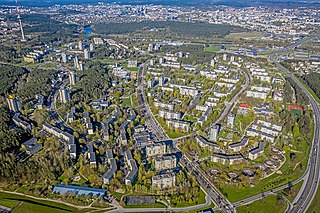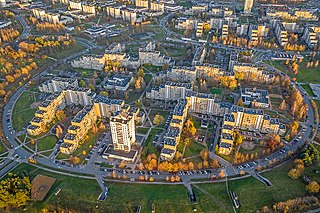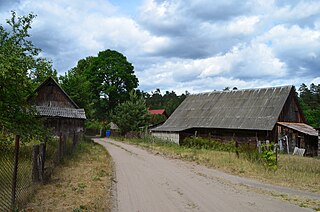Related Research Articles

This article is about the demographic features of the population of Lithuania, including population density, ethnicity, level of education, health, economic status, and religious affiliations.

Aukštieji Paneriai is a neighborhood of Vilnius, situated about 10 kilometres away from the city center. It is located on low forested hills, on the Vilnius-Warsaw road. Paneriai was the site of the Ponary massacre, a mass killing of as many as 100,000 people from Vilnius and nearby towns and villages during World War II.

A seniūnija is the smallest administrative division of Lithuania. An eldership may comprise a very small region consisting of few villages, one single town, or a part of a big city. Elderships vary in size and population depending on their location and nature. A few elderships make up a municipality. Šilainiai, Dainava, Verkiai, Žirmūnai and Pašilaičiai are the most populous elderates, with population counts over 40,000, around twice the population of some entire municipalities.

Vilnius District Municipality is one of 60 municipalities in Lithuania. It surrounds the capital city of Vilnius on 3 sides. The municipality is also bordering Trakai district and Elektrėnai municipality in the west, Astravyets and Ashmyany districts of Belarus in the east, Širvintos, Molėtai and Švenčionys districts in the north and Šalčininkai district in the south.

Šalčininkai District Municipality is one of 60 district municipalities in Lithuania. The municipality is part of the Vilnius County and is located in southeastern Lithuania, next to the Belarus–Lithuania border. The south-eastern border of the municipality with Belarus includes a distinctive salient of Lithuanian territory, known as the Dieveniškės appendix, almost completely surrounded by Belarus.
Russians in Lithuania numbered 140,000 people, according to the Lithuanian estimates of 2015, or 4.8% of the total population of Lithuania.

Hinduism is a minority religion and a fairly recent development in Lithuania. Hinduism is spread in Lithuania by Hindu organizations: ISKCON, Sathya Sai Baba, Brahma Kumaris and Osho Rajneesh. As of 2015, there were 580 (0.02%) Hindus in Lithuania.

Gričiupis is a neighborhood of the Lithuanian city of Kaunas, located on the right bank of the Nemunas River. It has elderate status, and is the smallest elderate in the city. Its administrative status as an elderate was established in 2005, when it was detached from Dainava elderate. In 2021 its population was 23,894 in an area of 3.81 square kilometers.

Vilijampolė is a neighborhood in the city of Kaunas, Lithuania, located on the right bank of the Neris River and the Nemunas River, near their confluence. Part of a larger Vilijampolė elderate which consists of Vilijampolė, Lampėdžiai, Panerys, and Veršvai neighorhoods, and covers 1,720 hectares with population of 23,687 people.

Lazdynai is an eldership of Vilnius, Lithuania, situated on the right bank of the Neris River. It covers a area of 9.9 square kilometres (3.8 sq mi) and has a population of 31,097. The word means "hazel bushes" in Lithuanian.

Pašilaičiai is an eldership in the Vilnius City Municipality, Lithuania. It occupies 7,9 km². According to the 2011 census, it has a population of 33,056.

Viršuliškės is an eldership in the Vilnius city municipality, Lithuania. It occupies 2,6 km2. According to the 2011 census, it has a population of 14,733.

Ginkūnai is a village located in Šiauliai District Municipality, Šiauliai County, Lithuania. The village is located on the northeastern border of Šiauliai and the western shore of the Ginkūnai Lake. Ginkūnai has a school, post office and library. There are also two agricultural cooperatives.

The city of Vilnius as of early 2023 had a population between 591,632. The actual number of city inhabitants could be higher as according to the Vilnius territorial health insurance fund, there were 732,815 permanent inhabitants as of January 2021 in Vilnius city and Vilnius district municipalities combined. According to the predictions, made by the municipality specialists of the city planning department of Vilnius, the number of inhabitants of Vilnius in 2030 could be between 630,3 thousand and 685 thousand with the basic scenario of 651,6 thousand inhabitants within the city borders.

Latežeris is a village in Druskininkai municipality, in Alytus County, in south Lithuania. According to the 2011 census, the village has a population of 35 people.

Dapšioniai is a village in the Radviliškis district in Lithuania, 3 kilometers northwest of Beinorava. The village is home to the Dievo Apvaizdos Bažnyčia, a Neoclassical church, as well as the Dapšionių ąžuolas - an oak tree 23 meters in height. The tree is under protection as an object of natural heritage of the state.
Baubliai is a village in Lithuania, specifically in the Akmenė district municipality. It is 9 km (5.6 mi) away from Papilė and is also close to Klaišiai forest, which is the source of the Eglesys.
Klaišiai is a village in the south of Akmenė district, 6 km (3.7 mi) from Šemetaičiai.

Zabičiūnai is a village in the Zarasai District Municipality, Lithuania. It is located 4 kilometres (2.5 mi) southwest of Antalieptė. According to the 2021 Lithuanian census, 37 people lived in Zabičiūnai. In the centre of the village there is a cemetery covered with maples, yews and olive bushes. A few gravestones have survived, with the oldest one having 1884 engraved on it. The last burial happened in July 1944, the name of the person was Kostas Morozov and he died by shrapnel from an exploding shell.
The Lithuanian census of 2011 collected demographic data of the country as of March 1, 2011. The census itself was conducted during March-May 2011. This was the second census in Lithuania after the restoration of independence and the first census since its accession to the European Union in 2004.
References
- ↑ 2021 m. gyventojų ir būstų surašymas, a leaflet for the 2021 census
- 1 2 Jūratė Petrauskienė, LIETUVOS GYVENTOJAI 2021 METAIS. Lietuvos Respublikos 2021 metų visuotinio gyventojų ir būstų surašymo rezultatai,
- ↑ "Ethnicity, mother tongue and religion". Official Statistics Portal. Statistics Lithuania. 15 March 2013. Archived from the original on 15 December 2018. Retrieved 15 December 2018.
- ↑ 2021 m. Gyventojų ir būstų surašymas: gyventojai gyvenamosiose vietovėse, January 15, 2022
- ↑ "Population by command of languages in municipality" . Retrieved 23 September 2022.